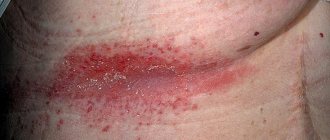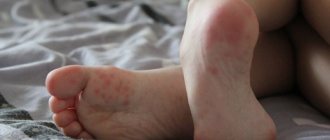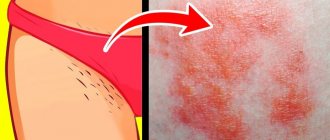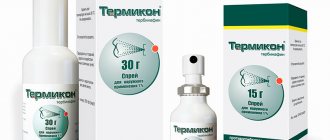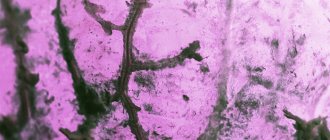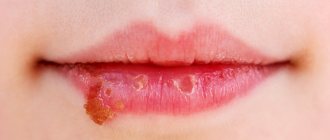General information
Diaper rash (intertrigo) is a type of simple dermatitis that affects only the superficial layer of skin in the folds and bends of the skin.
Diaper rash in adults is most often localized in the armpits, under the mammary glands, in the folds of the abdomen, neck, perineum or in the intergluteal fold. This pathology develops in areas of skin friction and high humidity under the influence of the irritating influence of sweat, sebaceous secretions, urine or feces. A high incidence of intertrigo is observed in patients with obesity , diabetes mellitus and immunodeficiency conditions . Diaper rash occurs at any age, and in infants this skin lesion is considered a type of diaper dermatitis , since changes in the skin appear in the diaper area (diaper area) and are associated with the irritating effect of urine or feces.
Initially, in areas of profuse sweating, simple diaper rash occurs, and with insufficient care and constant friction, the areas of inflammation become infected with fungal or bacterial flora and there is a risk of developing streptococcal and candida infections, as well as dermatophytosis . If simple diaper rash goes away quickly when irritating factors are eliminated and drying and anti-inflammatory drugs are prescribed, then treatment of streptococcal and candidal intertrigo is sometimes a difficult task, since there is a risk of relapses and chronicity of the process.
Intertriginous dermatitis: forms
- "Widespread." This form of the disease is called seborrheic dermatitis. In cases of this type of disease, diaper rash spreads from the gluteal region to the armpits.
- "Psoriasiform." This type of dermatitis is characterized by peeling skin.
- "Granulomatous". This dermatitis is often caused by a weakened immune system, and it has distinctive features in the form of brown rashes on the skin.
- "Herpetiform." This type of dermatitis is characterized by the appearance of blisters on the body.
Only a qualified dermatologist can diagnose intertriginous dermatitis. When making a diagnosis, a medical professional must conduct a distinctive diagnosis with diseases such as psoriasis, athlete's foot and eczema.
Pathogenesis
In the development of diaper rash, increased sweating and friction of the skin, which cause inflammation, are of primary importance. In addition, a higher temperature is created in closed folds of the skin compared to open and ventilated areas of the body. Accumulation of sweat and friction under elevated temperature conditions increase maceration (damage) of the skin. Fungi and bacteria contained on the skin actively multiply and lead to the development of skin infections. A decrease in skin protective factors and the presence of damage create conditions for pathogens to penetrate into the deep layers of the epidermis. Thus, dermatophytes (a type of fungus) have a keratolytic effect - they destroy the keratin of the stratum corneum, causing a pronounced and long-lasting inflammatory process.
Types and stages of progression of intertriginous dermatitis:
There are three stages of development of this disease: first, second and third.
- At the first stage of diaper rash progression, slight redness of the skin appears.
- The second stage is characterized by the appearance of microcracks and a rash.
- At the third stage of dermatitis, eczema appears.
Contact dermatitis is also a type of diaper rash. This dermatitis has characteristic signs, such as excessive weeping reddish rashes on the skin. This type of disease occurs due to contact with allergic pathogens. The manifestation of dermatitis in the groin area is its second type and is called “impetigo”.
Classification
Diaper rash occurs along the way:
- Spicy.
- Recurrent (constantly renewed).
- Chronic (lasts more than 1.5 months).
- Uncomplicated (simple).
- Complicated.
By etiological factor:
- Streptococcal diaper rash.
- Candida.
By severity:
- I degree - moderate redness of the skin.
- II degree - redness, superficial cracks and erosions.
- III degree - severe hyperemia , weeping surface and extensive weeping erosion.
The uncomplicated form is quickly treated and the patient’s general condition does not suffer. When a secondary infection occurs, they talk about infectious diaper rash, which is most often caused by fungi of the genus Candida and streptococci. Candidal intertrigo affects the interdigital folds (synonymous with interdigital yeast erosion) between the third and fourth fingers of the hands; the interdigital folds of the feet are somewhat less commonly affected.
Often the lesion is observed in one fold for several years, and then appears in other folds. The folds on both hands may also be affected. The disease begins with single blisters on the lateral surfaces of the fingers, which are in contact with each other. Then, in the interdigital fold, the skin macerates and acquires a whitish color. Against this background, erosion appears with a smooth and shiny surface of a dark cherry color. Cracks appear deep within the fold. The erosions increase in size and spread to the skin of the fingers, but when they are closed, the lesions are not visible, since it is limited only to the interdigital folds. The patient is bothered by itching, burning and soreness. Candidal erosion of interdigital folds has a persistent course and a tendency to recur.
When the interdigital spaces of the feet are affected, erosion occupies all the lateral surfaces of the contacting toes. The erosion surface becomes wet and is limited by a rim of exfoliated epidermis. In the depths of the interdigital spaces, deep cracks appear with fragments of the epidermis along the periphery. Candidiasis of the feet is complicated by bacterial purulent infection and inflammation of the lymph nodes.
Streptococcal diaper rash often develops against the background of diabetes and with this form, blisters (phlyctena) appear in the femoral-scrotal, axillary, intergluteal folds, under the breasts in women and in the folds of the abdomen. The blisters quickly open and an erosive surface appears, quite extensive, pink in color, delimited from healthy skin, and deep in the folds there are shallow painful cracks. The lesions grow along the periphery due to detachment of the stratum corneum. Patients are bothered by itching and burning. As a result of wetting, crusts appear in the lesions. This form is characterized by more pronounced inflammation compared to candidiasis, and there is also a tendency to spread to the foot.
Folk remedies for diaper rash
Irritation on the skin of the legs, between the buttocks, on the neck, diaper rash under the breasts in older women - all this is treated in different ways depending on the degree of skin damage. Traditional methods of treatment can make a person feel better (remove itching, flaking, burning), but you need to understand that serious infections must be fought with the help of special medications prescribed by the doctor.
Simple recipes for effective remedies that can be prepared at home:
- shampoo is mixed with vodka in a 1:1 ratio, especially disturbing areas of the body are wiped with this solution (this method is good when it is not possible to wash a bedridden patient); You can also use sea buckthorn oil, but first, the affected areas of the skin need to be washed with water;
- 2 tablespoons of oak bark, chamomile, string or celandine are poured into a glass of water, a decoction is made and the part of the body on which there is diaper rash is placed in this liquid;
- you can prepare an ointment: mix 3 drops of tea tree oil, 50 g of lard, half a teaspoon of yarrow powder, 5-6 drops of aloe vera juice (this ointment is applied to previously cleaned wounds up to 2 times a day after bathing until they are completely healed);
- homemade powder: dry buckwheat leaves, ground to flour;
- If you have weeping diaper rash, you can sprinkle it with club moss twice a day.
In addition, the following may help:
- Vegetable oils
. - Therapeutic baths
.
If older women have diaper rash in the groin, treatment may include applying vegetable oil to problem areas. First, the oil is brought to a boil, then cooled and used 2 times a day.
You can use sea buckthorn oil, olive and fir oils.
Baths with herbal decoctions are a good way to treat diaper rash, heal wounds, eliminate skin irritation, and also increase blood circulation. Baths with string and oak bark are especially effective. To prepare the decoction, take 50 g of each product, add 1 liter of water and boil for 10 minutes. The broth is cooled, filtered and added to the bath.
You can also prepare a chamomile infusion. To do this, pour 1 tablespoon of flowers with half a liter of hot water and leave for 30-40 minutes.
To relieve itching, eliminate peeling and inflammation, yarrow infusion is often used. It is prepared like this: pour 1 kg of grass with 3 liters of water and leave for at least 15 minutes.
Causes
In the occurrence of diaper rash, mechanical and infectious factors are of primary importance. The reasons for its appearance are:
- increased sweating and poor skin ventilation;
- uncomfortable and tight clothing, especially made from synthetic materials;
- trauma and friction;
- increased temperature and humidity of the environment, which explains the high level of seasonal morbidity;
- excess weight;
- excessive vaginal or rectal discharge;
- immobility of the patient;
- insufficient hygiene or lack thereof;
- decreased immunity .
Two predisposing conditions, obesity and diabetes, increase the incidence of diaper rash. If we consider the infectious factor, diaper rash can be caused by bacteria, dermatophytes and fungi of the genus Candida. Most often, damage to skin folds is caused by opportunistic and pathogenic fungi.
Bacterial and mixed bacterial-fungal infections take second place. Moisture creates the environment that is most favorable for the development of infection. Candida fungi in hot and humid climates become the main causative agents of secondary infection in diaper rash.
Symptoms
With diaper rash, the skin in the folds under the armpit or between the buttocks becomes inflamed and causes discomfort. The initial manifestation is a red spot without a clear border on both sides of the fold. The patient may be bothered by itching and burning.
The degree of inflammation depends on the location and duration of the process. If skin moisture is not eliminated and treatment is not carried out, the skin macerates (softens) and erosions and cracks appear on it. The inner thighs and crease between the legs are very delicate and the skin quickly becomes inflamed when in contact with rough fabric, moisture or urine. Increased sweating , insufficient ventilation and the presence of abundant hair in this area in men will provoke diaper rash in the groin, which appears in hot weather when walking and rubbing wet underwear against the skin.
If diaper rash is not treated and eliminated for a long time, candidiasis may develop, which covers the buttock and inguinal folds, as well as the skin of the perineum. In women, the vulva and skin under the breasts are often affected. Fungal infections develop against the background of diabetes , and the sources are microorganisms that colonize the surface of the skin. The incidence of fungal infections increases with age. Yeast diaper rash is characterized by maceration and rejection of the stratum corneum, after which a dark red, moist, erosive surface with clear boundaries is exposed. Around the main focus on the periphery, screenings appear in the form of vesicles and pustules. Opening up, they turn into erosions that increase and merge. The rash is accompanied by severe itching.
With candidiasis of the interdigital folds, the skin between the fingers is affected (on the hands more often than on the feet). A feature of the lesion of the feet is the large size of the lesion, which extends beyond the interdigital folds; damage to all interdigital folds is also characteristic. Patients are concerned about itching and burning, and if a bacterial infection occurs, pain occurs. The course of the disease is long and recurrent. With streptococcal infection, serous-purulent inflammation develops and blisters form, which are localized in the inguinal and intergluteal folds, under the abdominal fold, between the fingers and armpits. The skin of the folds is red, swollen, covered with a purulent coating that has an unpleasant odor, and there are wet erosions. Linear cracks are found deep in the fold.
In children
Diaper rash is a common pathology of newborns. At birth, the baby's skin is not mature enough and reaches functional maturity during the first year. Children's acidity levels, lipid levels and skin saturation with water are constantly changing, so proper care of the baby's skin is important.
Risk factors for diaper dermatitis are:
- increased trauma to the diaper area;
- increased skin moisture in these places;
- high skin pH;
- excessive wrapping;
- skin contamination with feces;
- poor hygiene care.
Prolonged stay in diapers leads to excessive hydration of the skin, loosening of the stratum corneum and the appearance of inflammation. Areas of the skin turn red, swell, a small rash appears, itching and burning. If the newborn's hygiene is not maintained, the process progresses: the intensity of redness and the affected area increase, cracks appear in the folds and an infection caused by staphylococcus, enterococcus or Candida occurs. Blisters, pustules and crusts appear in the affected areas.
Treatment for mild diaper rash includes:
- Frequent diaper changes (for newborns every 2 hours, and for infants from 1 month - every 3.5-4 hours.
- Bath babies regularly and dry folds thoroughly.
- Frequent and prolonged skin contact with air.
- Treatment of folds with powder and ointment/cream D-Panthenol . D-Panthenol cream forms a protective barrier to various irritants and has an anti-inflammatory effect. It should be used at every diaper change to treat and prevent mild to moderate diaper rash.
- The use of products containing zinc oxide ( Sudocrem , Zincoderm baby , Bübchen , Desitin ).
In severe forms, complex treatment is used: antifungal agents, local antibacterial drugs and glucocorticoids, which should be recommended by a doctor.
Prevention
For patients prone to excessive sweating and diaper rash, it is important to follow the following recommendations:
- Dress according to the season, do not wear tight underwear and avoid synthetic clothing.
- During the hot season, work in an air-conditioned room.
- Follow hygiene procedures daily, dry the folds thoroughly, wipe with salicylic alcohol and powder them with a mixture of talc and zinc oxide .
- After bowel movements and urination (involuntary and natural), wash the skin folds.
- Take frequent air baths (lie with your arms up, legs out, place rollers between your fingers, thus spreading your fingers).
- Bedridden patients often change their underwear (bed and underwear) to dry ones.
- In case of candidiasis of the skin, bedding and underwear should be disinfected by boiling.
How to get rid of diaper rash for older women
Due to the fact that some functional disorders in the body often lead to the appearance of diaper rash, it is necessary to direct efforts to combat these diseases. For example, increased sweating and the appearance of ammonia on the skin are not the norm. It is important to understand which body system has failed. Often you need to make changes to your usual diet.
If an elderly woman suffers from increased sweating, which leads to diaper rash, then it is recommended:
- take a shower twice a day and do it regularly;
- if primary redness of the skin appears, immediately begin treating this area with a solution of salicylic or boric acid;
- treat problem areas with baby powder, talcum powder or, for example, potato starch;
- drink less;
- do not abuse foods and drinks that increase sweating and have a diuretic effect.
How to treat diaper rash in older obese women? As a rule, you need to start with water procedures: take a bath and add an infusion of medicinal herbs that have an antiseptic and wound-healing effect. After taking a bath, the skin is dried and a special treatment is applied to it. It can be:
- antiseptic, antimicrobial solutions (tablets), for example, furatsilin, chlorhexidine, potassium permanganate, boric acid;
- antihistamines to relieve itching and irritation (Claritin, Suprastin, Diazolin);
- fungicidal creams – Decamine, Nystatin, Clotrimazole (if a fungal infection has occurred);
- wound healing drugs (Levomekol, Solcoseryl, sea buckthorn oil).
To treat diaper rash in older women and men, the following are most often used:
- Bepanten
(accelerates wound healing, eliminates skin rashes). - Nystatin
(has an antibiotic, antifungal effect, quickly suppresses pathogenic microorganisms). - Salicylic ointment
(relieves inflammation, eliminates rashes, helps exfoliate dead epithelial cells). - Boltushka, or zinc ointment
(helps with advanced dermatitis, has a softening, drying effect). - Teymurov's paste
(dries the skin, relieves inflammation and pain). - Burov's liquid
(it is diluted at the rate of 1 tablespoon per glass of water, lotions are applied to the affected areas of the skin). - Tannin
(1%).
In bedridden patients, diaper rash often leads to bedsores. In this case, it is extremely important to remove pus and other deposits from the affected area. This is often difficult to do at home, so the patient is sent to a surgeon, and sometimes to a hospital. This is due to the fact that in advanced cases it is necessary to clean the wound and apply a bandage with a special antiseptic twice a day. Such procedures promote rapid healing of wounds and accelerate tissue regeneration.
If there are weeping, non-healing areas of the skin (for example, irritation between the buttocks or diaper rash under the abdomen in older women), treatment may include compresses from solutions:
- resorcinol
; - copper sulfate
.
After the wound has dried and crusted over, the doctor prescribes Glucocorticosteroids (Lorinden, Locacorten)
.
Important! Oil-based creams and ointments (greasy) can only be used when the wound is dry and the cracks have healed, otherwise it can cause increased inflammation.
If the patient has a streptococcal infection, then treatment is accompanied by taking antibiotics, and then he is prescribed immunomodulatory drugs, for example, Echinacea or Imudon.
In the process of treating diaper rash, you can use a Minin lamp. With its help, deep subcutaneous layers are heated with infrared rays, this helps to increase blood circulation, normalizes metabolism, improves tissue trophism, relieves inflammation, and can eliminate diaper rash at the initial stage of development.
We recommend
“Treatment of cerebral ischemia in the elderly: features and recommendations” Read more
List of sources
- Samtsov A.V., Sukharev A.V., Nazarov R.N., Bondar O.I., Patrushev A.V., Fedotova M.A. The effectiveness of Pimafukort cream in the treatment of patients with intertrigo of fungal etiology / Russian Journal of Skin and Venereal Diseases. 2011;14(4):42-46.
- Dermatovenereology: National manual edited by prof. Yu.S. Butova //Moscow. "Geotar-Media", 2014, p. 886.
- Nosonova A.V. Complex differentiated therapy of patients with infections of large skin folds using etiotropic drugs and immunomodulators / Dermatovenerology. Cosmetology. Sexopathology. — 2012.— No. 1-4.— P. 297-302.
- Skripkin Yu. K. et al. Skin and venereal diseases: A guide for doctors. – M., 2001. – P. 4-13
- Gorlanov I. A., Zaslavsky D. V., Leina L. M. Skin diseases associated with obesity / Bulletin of Dermatology and Venereology. - 2016. - No. 6, pp. 20-26.
